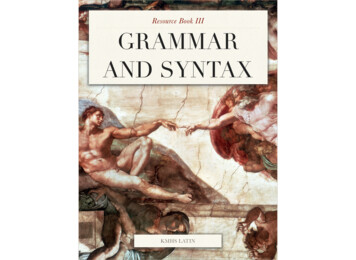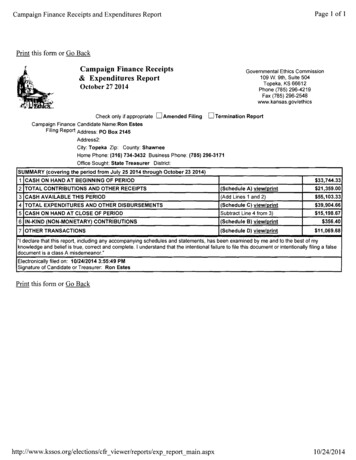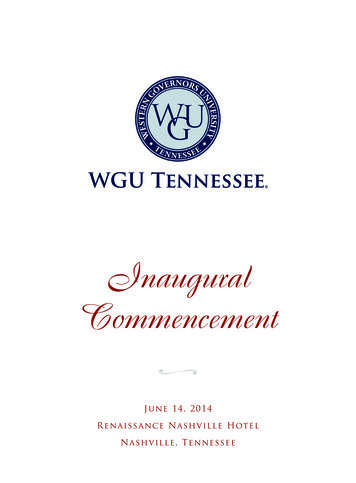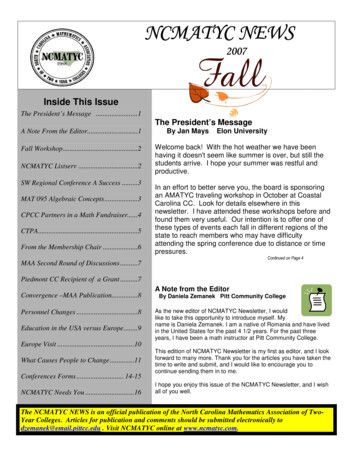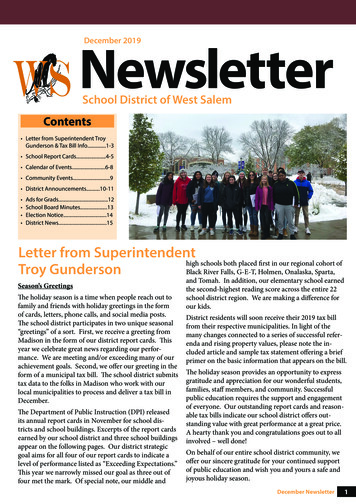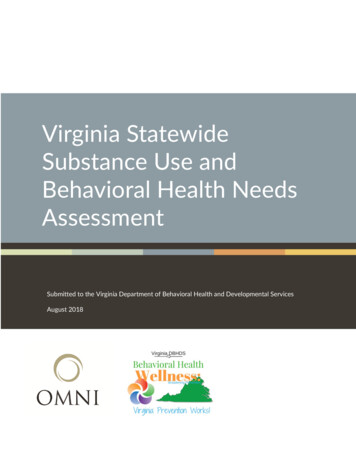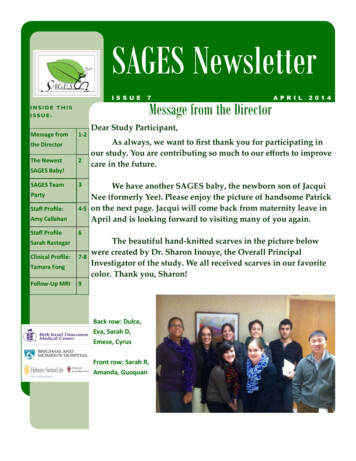
Transcription
SAGES NewsletterIS S UEINSIDE THISISSUE:Message from1-2the DirectorThe Newest2SAGES Baby!SAGES Team3PartyStaff Profile:4-5Amy CallahanStaff Profile7-8Tamara FongFollow-Up MRIMessage from the DirectorA PR I L2 01 4Dear Study Participant,As always, we want to first thank you for participating inour study. You are contributing so much to our efforts to improvecare in the future.We have another SAGES baby, the newborn son of JacquiNee (formerly Yee). Please enjoy the picture of handsome Patrickon the next page. Jacqui will come back from maternity leave inApril and is looking forward to visiting many of you again.6Sarah RastegarClinical Profile:7The beautiful hand-knitted scarves in the picture belowwere created by Dr. Sharon Inouye, the Overall PrincipalInvestigator of the study. We all received scarves in our favoritecolor. Thank you, Sharon!9Back row: Dulce,Eva, Sarah D,Emese, CyrusFront row: Sarah R,Amanda, Guoquan
Please enjoy the many pictures of our team in this edition as well asthe interviews with Amy Callahan, Sarah Rastegar, and Dr. Tamara Fong.Amy works with the MRI sub-study and designed this wonderfulnewsletter. Thank you, Amy! Sarah Rastegar and Dr. Tamara Fong bothwork with the Clinical Outcomes sub-study. Dr. Fong, a neurologist atBIDMC, explains the importance of this sub-study in her interview. Finally,Dr. Alsop, Director of the Center for Advanced MRI at BIDMC, providesyou with some background information on why the MRI one year followup visits are so valuable for the study.As always, please do not hesitate to call me on my direct line(617-971-5392) if you have any questions or concerns. Thank you again forall your support. We could not do the study without you.With my very best wishes,Eva Schmitt, PhD, Study DirectorThe Newest SAGES Baby!Many of you have sat downwith Jacqui Nee (formerly Yee)for one of your interviews. Weare so happy to announce thebirth of her first child,Patrick George Nee Jr.He was born onDecember 14, 2013 andweighed 8 pounds 14 ounces.Patrick is featured here withhis SAGES onesie!http://www.hebrewseniorlife.org/sages1200 Centre Street, Boston, MA 02131 phone 617.971.5390PAGE 2
PAGE 3Team SAGES Party!We celebrated another successful year of the study with a party in January!Jackie Gallagher, Margaret Puelle, and Sarah RastegarCyrus Kosar and Dr. Sharon InouyeDue to the craziness of the holidayDr. Tamara Fong, Dr. Ed Marcantonio,Dr. David Alsop, and Dr. Sharon InouyeDr. Donna Fick, Emese Nemeth, Dr. Eva Schmitt,Margaret Puelle, Cyrus Kosar, Amanda Brown,Sarah Rastegar, Jennifer InloesFeatured right (from L to R):Dulce Piña, Dr. Weiying Dai (in back),Dr. Guoquan Xu, Sarah Dowal, Dr. Long Ngo
PAGE4Staff Profile: Amy CallahanHi everyone! I am the new editor of the SAGESNewsletter. I hope that the following details providesome helpful information for you to get to know mebetter! Also, if there is anything in particular that youwould like to be included in the newsletter, please emailme and let me know at aecallah@bidmc.harvard.edu.My Role in the SAGES Study:Quote from aStudy Participant:“I participated inthe SAGESprogram in thepast 6 months. Ijust want to tellyou how excellentEmese was as apresenter/tester.She was sorespectful andinterested andsuch a brightspirit. It alwaysmade my daywhen she came.It was my greatpleasure to serveas part of thisstudy.”-I am the Clinical Research Assistant for the MRI portionof the SAGES study. I am responsible for calling those ofyou who completed a baseline MRI to see if you arewilling to return to Beth Israel Deaconess MedicalCenter for a 1 year follow-up MRI. I have met with manyof you to guide you through the MRI experience. I haveenjoyed meeting you, and I look forward to meetingmany more participants!My Background:-I grew up in Syracuse, NY and graduated from St.Lawrence University in May 2013. I majored in Englishwith a focus on creative writing, minored in biology, andcompleted all of the Pre-Med pre-requisites. In college, Ienjoyed working as a tour guide for the admissionsoffice as well as a teaching assistant in the biologydepartment. I am in the process of deciding if I want toapply to medical school or to nurse practitionerprograms. I welcome any and all advice on that matter!
PAGE5Staff Profile: Amy CallahanWhat I Like to Do for Fun:-I enjoy spending time with my two older brothers who are closeby. I also love to sing! I have been singing since I could talk, and Iwas a member of a select choir while I was at St. Lawrence. Wetraveled to France during my sophomore year to perform aroundthe country!My Travels:-Yes! I spent nearly 4 months studying abroad in Tuscania, asmall town in Italy. I lived with a host family that didn’t speak anyEnglish, so I really had to work on my Italian! They became mysecond family, and I can’t wait to go back and visit! While I wasthere, I traveled to Barcelona, Vienna, Ireland, as well as to manyother cities/towns in Italy. It was a life-changing experience that Iwill always treasure.My Favorite Part of My Job:-YOU! I have truly enjoyed my interactions with the participants.I also appreciate the fact that you have been willing to return toBIDMC for another MRI. It is a crucial aspect of the study!Here is the view from the park inTuscania, Italy. I lived here for 3.5 months!Holding the Leaning Tower of Pisa!
Staff Profile: Sarah RastegarSarah Rastegar is a Clinical Research Assistant with theSAGES study. She received her master's in psychology in2012 from the University of Southern California in LosAngeles, CA. Sarah’s professional and educationalbackground has focused on clinical research exploringcognitive functioning and mental health in older adults.Amy: What is your job?Sarah: I work as a research assistant with the SAGES study.I spend most of my time outside of the office doinginterviews with study participants. I also help to coordinate a sub-study of the SAGESproject called the Clinical Outcomes sub-study (see Dr. Fong’s interview on pages 7and 8).Amy: What has been the most challenging aspect of your job?Sarah: Driving directions have never been my strength - I’m not the best at figuringout the most direct route to participants’ homes. Thank goodness for GPS (globalpositioning systems)!Amy: What is your favorite aspect of your job?Sarah: Working with the SAGES team has been a great experience. Myfavorite part of my job has been getting to know the participants in our study. I alsoreally enjoy the fact that research involves constantly learning. I am taughtsomething new all the time, both by my colleagues at SAGES and by participants inthe study!Amy: How do you spend your free time?Sarah: Some favorite hobbies of mine are cooking and baking. I also love doing artsand crafts, and particularly enjoy hunting for bargain vintage furniture pieces andthen working to restore them. I recently found a beautiful old cabinet which, with afresh coat of paint, is now sitting in my dining room!Amy: What is your favorite thing to do in Boston?Sarah: One of the best parts of Boston as a city is how walkable it is. Weatherpermitting, my favorite thing to do in Boston is to take the T downtown and then towalk from neighborhood to neighborhood.PAGE 6
Clinical Profile: Dr. Tamara FongTamara Fong, MD, PhD is an Assistant Professor ofNeurology at Harvard Medical School. She attendedOhio State University College of Medicine to earnher medical degree, and she later completed herresidency and fellowship at Beth Israel DeaconessMedical Center. Tamara works with Sarah Rastegar(from page 6) on the Clinical Outcomes sub-study.Here she explains her role. Enjoy!Amy: What is your job?Tamara: I am a Neurologist and I specialize in the evaluation of memoryand thinking in patients.Amy: How would you describe the Clinical Outcomes sub-study?Tamara: It is a sub-study of the SAGES study in which patients undergoadditional cognitive testing, lab work, and neuroimaging, in order that wecan take a closer look at memory and thinking abilities. In addition, patientsare also interviewed and examined by a neurologist who has expertise inmemory functioning.Amy: Why do you think this sub-study is important?Tamara: It’s an important study because we really wanted to take a closerlook at how people’s thinking and memory skills might change after surgery.In the SAGES study we do collect a lot of important measurements fromwhich we can get a good picture of how people are doing, but nothingreally beats having a chance for an expert doctor to meet with someoneone-to-one and do an evaluation that way.PAGE 7
Clinical Profile: Dr. Tamara FongAmy: What has been the most challenging aspect of your job?Tamara: Probably juggling my research responsibilities with my clinical andteaching responsibilities, and taking care of my family – it’s like I have threefull time jobs!Amy: What is your favorite aspect of your job?Tamara: I love working with patients. In particular, I really enjoying talkingwith older patients and hearing stories about things that they do and thingsthat they used to do. Our patients have done some pretty interesting thingsand made huge accomplishments in their field. Others are still activelyinvolved in surprising things.Amy: How do you spend your free time?Tamara: Well, I don’t have very much of that! Our youngest is just turningone so he has kind of slowed us down a bit, but we enjoy biking, hiking,and traveling. When I first came to Boston as a neurology resident I tooksailing lessons on the Charles River. I’d love to get back into that and sail outin the ocean if I ever had enough time!Amy: What is your favorite movie and why?Tamara: I enjoy a wide range of films, from spy thrillers that feature JamesBond, Jack Ryan, or Jason Bourne, to rom-coms like Love Actually, and thenof course due to popular demand at my house, anything with a DisneyPrincess in it (especially Rapunzel or Cinderella). But if I were stucksomewhere with only one film, I’d have to say the Shawshank Redemptionwould be the one I’d take. It’s just so well written and superbly acted, andthe themes of friendship and hope are really inspiring.PAGE 8
Why is the 1 Year Follow– Up MRI Important?By: David Alsop, PhD (Project Investigator for the SAGES Study)The key focus of the SAGES study is to understand how theexperience of undergoing surgery and being hospitalized affects the healthand activity of older adults. The MRI sub-study of SAGES is designed tomeasure any detectable changes in the brain one year after surgery usingstate-of-the-art measures of brain tissue structure and activity. In order tomeasure these changes, we first imaged a subset of the SAGESparticipants before undergoing their surgery. To learn about the effects ofhospitalization and surgery on the brain, we need to image these subjectsagain one year later. Though we cannot be sure until we study the results,we hope that the knowledge gained from this study will help to improvethe hospital and surgical experience of future patients and will reduceeffects on their brain and brain function. We understand that coming toBeth Israel Deaconess Medical Center to be reimaged can be an addedburden in our participants’ lives, but the benefit to the understanding ofsurgery’s effects on the brain is tremendous. If you participated in an MRIbefore your surgery, you should be contacted near the anniversary of yoursurgery. We hope you will consider continuing to donate your time byscheduling a time for your scan when we call. Our MRI study staff arelooking forward to seeing you again!This is the MRI Scanner where all of the imaging takes place!PAGE 9
Tamara Fong, MD, PhD is an Assistant Professor of Neurology at Harvard Medical School. She attended Ohio State University ollege of Medicine to earn her medical degree, and she later completed her residency and fellowship at eth Israel Deaconess Medical enter. Tamara works with Sarah
